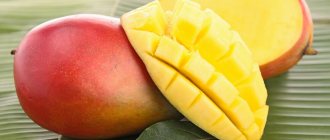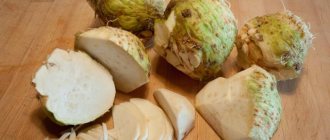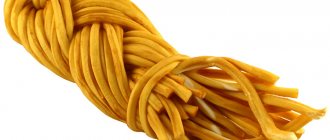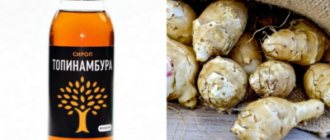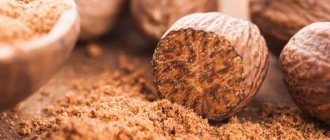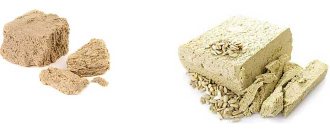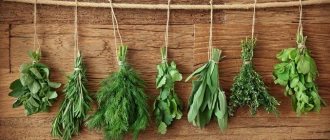Properties of cilantro
Nutritional value and composition | Vitamins | Minerals
How much does cilantro cost (average price per 1 kg)?
Moscow and Moscow region.
355 rub.
In our country, cilantro is traditionally used to call fresh green seasoning, and coriander is the seeds of the same plant. Historically, this plant is native to the Mediterranean. By the way, the first who began to eat cilantro were the ancient Greeks, who noticed the similarity of the aroma of this spice with the smell of bedbugs. And in fact, some people believe that cilantro greens have the smell of these insects. But this only applies to the case when the plant is not yet fully ripe, since when it is saturated with essential oils, the unpleasant tint in the smell disappears.
Well, as for the benefits of cilantro, they are truly enormous. Even the ancients used this spicy herb in magical rituals, and nowadays cooks add it as an aromatic seasoning to salads, soups and meat dishes. The calorie content of cilantro is 23 kcal per 100 grams of greens.
Medicinal properties of cilantro: uses and recipes
1. For digestive disorders and restoration of the gastrointestinal tract.
You need to: grind 20 grams in a mortar. coriander, pour a liter of hot water, let it brew for 3-4 hours. Take one glass of drink after meals.
2. To eliminate bad breath, even the “flavors” of tobacco and alcohol.
You need to: pour 15 grams into a saucepan. dry cilantro, pour 400g. water, cook the broth for about 10 minutes over low heat after boiling. Allow the broth to cool and you can rinse your mouth every morning or as needed.
3. To restore the nervous system and eliminate depression.
You need to: grind 30 grams. fresh herbs, pour 100 gr. vodka, leave for two weeks in a glass jar. Then strain the tincture through cheesecloth. You can take 50 drops every day for two weeks. This tincture has a calming, anticonvulsant, and antidepressant effect.
4. With a strong cough to expel sputum as quickly as possible.
You need to: mix 2 teaspoons of fresh herb juice, 1 teaspoon of sugar, 0.5 teaspoon of grated ginger root. Take one teaspoon per day.
5. From a hangover.
You need to: mix celery root, cilantro, parsley, dill in equal proportions in a blender, add a glass or one and a half of clean water. The cocktail will remove toxins from the blood and relieve hangover.
The benefits of cilantro
The benefit of cilantro undoubtedly lies in its rich composition, which includes vitamins C, B, PP, rutin, carotene, pectin, aromatic oils, ascorbic acid, macro and microelements. Having a beneficial effect on the functioning of the cardiovascular system, it also normalizes digestion processes, while helping to digest heavy foods faster and easier. There is an opinion that if you chew the seeds of this plant a little, the effect of alcohol during intoxication will noticeably decrease.
From a medical point of view, the beneficial properties of cilantro are manifested in the antiseptic, analgesic and choleretic effects that this medicinal herb has for gastritis. It is considered an excellent assistant for various colds, and also as an expectorant.
The benefits of cilantro are also indicated by the fact that it has the ability to strengthen gums, relieve stomatitis and even prevent the occurrence of caries. The essential oils contained in fresh cilantro can have a powerful anti-inflammatory and antiviral effect on the body. At the same time, they are easily eliminated from the body through the urinary system, having a beneficial effect on the kidneys and bladder.
Application
Cilantro has a distinct taste and smell and serves as a traditional seasoning in Caucasian cuisine. The juice from the leaves is used in medicinal teas. Cilantro is also added to vegetable juices along with a slice of lemon.
Green cilantro is easy to damage and spoils quickly. Fresh herbs will keep in the refrigerator for about a week. To protect it from moisture, it is better to first wrap the cilantro in newspaper, then put it in a plastic bag. Before cooking, soak the greens in cold water for 10 minutes to crisp them up again.
Market Analytics
- COVID-19 is changing the rules of the game in the cosmetics market
- Beauty of the future: cosmetic innovations 2020
- New ingredients are the driving force of the cosmetics industry
Convenient search for beauty salons on our website
Beauty salons in Moscow Beauty salons in St. Petersburg Beauty salons in Ekaterinburg Beauty salons in Novosibirsk
Latest blog posts on our website
- Naturecream / Geranium (Pelargonium) oil for skin health and beauty
- Prostye-sovety / Save on a beauty salon: procedures that can be done at home
- Naturecream / Growth Factor - brings back youth?
- Oksana-Lezina / 3 effective abdominal exercises from a fitness instructor for beginners
- Prostye-sovety / Making perfect curls at home
- Prostye-sovety / Which hair removal method to choose
- Naturecream / Wrinkles Puppets
- Naturecream / PEPHA-TIGHT - instant skin lifting
- Naturecream / Blue light - a danger to the skin
- Naturecream / Cocoa Butter – A treat for the skin
Latest forum topics on our website
- Mrs._Smith / Badly sunburned! What to do?((
- Ice / Is it necessary to combine fitness classes with a diet?
- Antonova / What can be used for hair loss?
- Radio operatorKat / Who was on a protein diet?
- Suzanna / Mesotherapy on the face
Other articles in this section
| Pickled capers Capers are considered a delicacy and are used as a seasoning in Italian cuisine. These are immature buds of the wild caper plant. It does not like frost and grows in Southern Europe only at above-zero temperatures. It is difficult to grow capers on purpose; they prefer places sheltered from the wind - along walls and hedges. |
| Boiled beans Beans, like peas, belong to the legume family. The bean is native to Latin America, from where Spanish colonialists brought it to Europe in the Middle Ages. As a rule, this is a climbing plant, but bush varieties are also found. Bean fruits are hard, round seeds hidden in oblong pods. There are many types of beans, which differ in color, shape, and pod length. |
| Purple carrots The variety of orange carrots was developed in Holland only in the 17th century. Before this, they grew carrots that were dark purple, almost black. This color is due to the high concentration of anthocyanins - nutrients that are extremely beneficial for health. |
| Boiled beets Beetroot is a unique source of betalain alkaloids. It is they who give the root crop its purplish-red color. Unlike anthocyanins, which give a dark purple color, betalains are destroyed by heat treatment. This explains why beets turn pale during cooking. |
| Green beans Green beans belong to the genus Common bean, legume family. It is popular both in European cuisine and in Asian and African countries. This versatile vegetable crop grows in various climatic conditions, which is why it has become so widespread throughout the world. Bean pods are picked green without waiting for ripening, which is why they are also called green beans. |
| Lima beans Lima beans belong to the legume family and are one of the oldest vegetable crops cultivated by humans. The homeland of beans is the fertile tropical plains of Central America, where the Mayans and Aztecs, and then the Incas, began to cultivate them. There are two varieties of lima beans. One grows as a bush and is distinguished by small seeds. The other is a climbing vine and requires staking. Climbing bean seeds are larger, approximately 4x2.5 cm. |
| Celery Celery is a vegetable crop of the Apiaceae family, a relative of parsley. A variety of wild celery began to be grown in the Mediterranean and other European regions around the 10th century. BC e. In Ancient Egypt, celery was used as a medicinal plant, and in Ancient Greece, celery leaves were awarded to athletes for victory. Now celery is cultivated all over the world and is considered the most useful dietary vegetable. |
| Pickled garlic Garlic is one of the most famous and widespread seasonings. Small cloves of garlic are a real storehouse of vitamins and microelements. Pickled garlic retains almost all the beneficial properties of raw garlic. It has its own taste and smell, not as strong as fresh garlic. The shelf life of pickled garlic ranges from two to seven years. |
| White radish White radish is a juicy, oblong-shaped root vegetable with a pronounced pungent taste. Belongs to the cruciferous family and is a relative of cabbage, radishes, and broccoli. Not only the root vegetable is eaten, but also radish tops, flowers and seeds. This vegetable crop has been known for its healing properties since ancient times. In Asian countries, varieties of white radish such as daikon and Chinese (Margelan) radish are common. |
| Chickpeas Chickpeas, or chickpeas, are a legume plant traditionally grown in the Middle East. In this region, protein-rich legumes still form an important part of the diet. It is also called Turkish peas. The first mention of chickpeas occurs about seven thousand years ago. It was grown by the ancient Egyptians, Greeks and Romans, and in the Middle Ages, Spanish and Portuguese travelers brought the crop to the New World. |
Cilantro: benefits and harm
If we talk about the chemical composition of this plant, then the picture is very attractive. Cilantro contains:
- Carotene;
- Pectin;
- Rutin;
- Vitamins C, P, B1 and B2;
- Essential oils;
- Microelements.
In addition, it contains seven different organic acids: oleic, isooleic, ascorbic, palmitic, myristic, linoleic and stearic.
The calorie content of cilantro is 216.4 kcal. Nutritional value: fats – 0 g, carbohydrates – 55 g, proteins – 3 g. Of course, all calculations are presented per 100 g of product. This means dried ground cilantro. Although these indicators differ for other products, they are not significant.
Useful properties of cilantro
One of the most important positive properties of this herb is the elimination of pain. Dishes using this product can cause a diuretic effect. Many doctors in China recommend using this herb in the final stages of acute respiratory infections and influenza due to its expectorant properties. One cannot fail to mention the ability to remove worms. True, a more serious approach is needed here.
The Romans, by the way, were not mistaken. Cilantro can really significantly improve your appetite. It improves intestinal motility, thereby optimizing the digestion process. If you can't sleep, then just eat this herb - it will help. Cilantro is also useful for those who suffer from unstable blood pressure.
It is impossible not to mention the antibacterial properties of this plant. It is incredibly useful for people suffering from diseases of the gastrointestinal tract. This herb almost completely eliminates bacteria that cause poisoning. And cilantro juice helps treat stomatitis, relieves toothache, and also reduces bleeding gums. It is perfect for lovers of heavy food, as it helps to digest it easier.
We can safely say that cilantro has very different benefits and harms. For example, it has a beneficial effect on the cardiovascular system and can remove cholesterol from the body. But the most important advantage, probably, this herb is for those who like to take it on the chest. The elements contained in the plant help reduce the negative effects of alcohol on the body.
Essential oils have very strong antiviral and anti-inflammatory effects. And due to easy excretion, they can have a positive effect on the bladder and kidneys. So, if you have problems on this part, then take this information into account. However, it is unlikely to be treated with the plant. For more detailed information, it is better to consult a doctor.
Harm of cilantro
It’s not for nothing that this article is called “cilantro: benefits and harm”, since in addition to positive properties, this herb also has negative ones.
Firstly, it is better not to use this plant for pregnant women and women who are breastfeeding. Secondly, cilantro is contraindicated for people who have suffered a myocardial infarction or stroke. Thirdly, this herb should never be used by people suffering from thrombophlebitis.
With excessive consumption of this herb, negative consequences are noted: memory begins to weaken, sleep becomes restless, and women’s periods lose regularity. So you shouldn’t eat this seasoning in batches. The optimal amount is 35 grams per day (4 grams of seeds).
Doctors strongly do not recommend consuming cilantro for people suffering from diabetes, hypertension, thrombosis, cardiac ischemia and gastritis with high acidity. You should also refrain from consuming this plant if you have already received the required dose of vitamins C and A that day. Otherwise, poisoning may occur.
Use of cilantro on the farm
Coriander oil is a real lifesaver for sensitive skin. I already know!
If Hippocrates himself treated his ancient Greek patients with parts of this plant, then its benefits are certainly beyond doubt. The ancient Egyptians also widely used coriander, not only in their many religious rituals, but also as a medicine. The Chinese who lived a long time ago did not lag behind them.
Very often, this greenery and its fruits are prescribed by Ayurvedic doctors, and my story is no exception. I am encouraged to eat cilantro in all its forms, which I do with pleasure! Modern traditional medicine has also recognized the beneficial properties of coriander seed and recommends medicines made from it as a choleretic and gastric remedy.
Coriander is included in the corresponding herbal preparations and helps with gastritis and ulcers. Essential oils extracted from the plant and converted into the substance “linalool” are used to treat catarrh of the upper respiratory tract in the form of drops and cough drops.
Coriander fruits help against worms, scurvy, inflammation, colic, and increased gas formation.
They are also a powerful analgesic, antiseptic and antiviral agent.
Citral aldehyde is produced from coriander oil, which is used to treat various eye ailments, including conjunctivitis and glaucoma. Nursing mothers who do not want to use chemicals during lactation lubricate the cracks in their nipples with this oil.
This healing substance is widely used to restore skin and treat hair. You can also add this oil to salads – it gives the appetizers a characteristic coriander aroma.
Essential oils obtained from this plant were used in perfumery and cosmetology by the beauties of Ancient Greece. Today, perfume and cosmetics manufacturers continue this tradition. These oils are also used in the technical industry, in soap making, and in textile production.
After squeezing the oil, coriander meal remains, which is added to feed for farm animals and birds.
Seed coriander is an excellent honey plant. Bees like fragrant small umbrella-shaped flowers, and therefore beekeepers can get up to 250 kilograms of honey from 1 hectare of cilantro. Yes what! Coriander! Preserving a lot of useful properties and the amazing tart smell of this plant. Have you tried this honey? Do you love him?
How to grow cilantro at home?
If you like cilantro, you can easily grow it even in your city apartment on the windowsill. This plant is unpretentious and can survive in almost any conditions (even wild ones!), as long as there is enough moisture. Otherwise, the leaves of the bushes will be hard and the smell will be very pungent - so that the bugs are resting!
